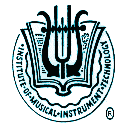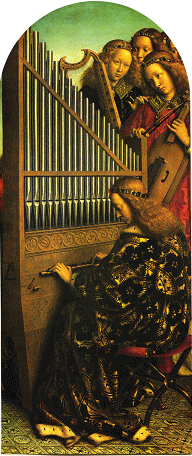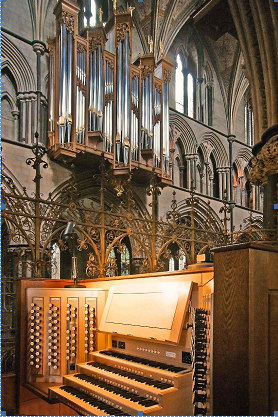
 |
INSTITUTE OF MUSICAL INSTRUMENT TECHNOLOGY
|
The Organ

The organ was the first keyboard instrument, invented about 250 BC. The Emperor Nero’s wife was said to have been an early player. The oldest surviving organ was made about 1400 AD but in Britain all the early organs were destroyed, many by Cromwell’s troops in the 1640s. Most existing organs are in churches and town halls, but some 1930s Theatre organs (built to accompany silent films) survive, mostly in private ownership. New organs continue to be made in the UK, with exports to America and even to Japan. The transfer of organs from one venue to another (organ transplants !) goes on all the time.
The organ is a wind instrument but, unlike other wind instruments, an organ has a separate pipe for each note. The pitch of the organ can reach both the upper and lower limits of the human ear. Variety of tone is provided by different sorts of pipes and even a medium-sized instrument may well contain over 1,000 pipes ranging in length from 16 feet down to a few inches. For flexibility in playing, the pipes are often grouped in separate departments, each with its own keyboard, so that players can quickly switch from one sound to another. The largest and deepest-toned pipes are usually played with the feet from a pedal keyboard. The organ has a greater variety of sound than any other single instrument. Its flexibility makes it relevant to many different styles of music. The sustained sound provides more support to the human voice than any other instrument.
Organs last a long time. The need to commission a new instrument or renovate an old one should not happen very often. However, when work is needed, it can be a major project. Not all organbuilders are the same. Some specialise in new instruments, some in the restoration of historically-important existing organs and some offer a more comprehensive restoration service. Others are basically organ tuners with little in the way of manufacturing facilities. When seeking quotations it is important to approach only those firms whose repertoire matches your requirements. Professional advice is available from accredited specialists listed on the website of the AIOA (www.aioa.org.uk). 
The National Pipe Organ Register (www.npor.org.uk) contains details of 31,000 organs including 10,000 pictures and 260 sound recordings. It is relatively easy to search for information about an organ even if you don’t know the exact address; just the town or village will do. The register currently handles about 1,500 queries every day. It also logs which organs are listed with Historic Organ Certificates.
Electronic Organs (‘Digital’ organs)
Because of the cost of large conventional organs and the space required to accommodate them, electronic organs were first developed in the 1930s. Such instruments simulate the sound of organ pipes using electric currents to energise loudspeakers. The playing technique is the same as with conventional organs.
Early instruments used rotary electrostatic or electromagnetic frequency generators, joined later by oscillating valve circuits. From about 1965, production switched from hot valves to transistors, with a big improvement in reliability. In the 1970s, makers changed from analogue sound generation to digital circuits, with a consequent improvement in the quality of simulation. In recent times, more affordable silicon-chip memory has enabled most makers to use the digitally-recorded sounds of real organ pipes as the basis of their instruments.
Images
Top image: Semi-portable fifteenth-century organ.
Painting by Jan van Eyck, 1432 in St Bavo’s Cathedral, Ghent, Belgium.
Second image: New four-manual organ in Worcester Cathedral, made by Kenneth Tickell in 2008
Master
12-05-2025Master
12-05-2025First Tuning in 17 years
21-03-201801-06-2026 01:00PM
08-02-2026 07:00PM
Meeting of IMIT Council in London
03-07-2024 01:00AM
08-02-2026 07:00PM
01-06-2026 01:00PM